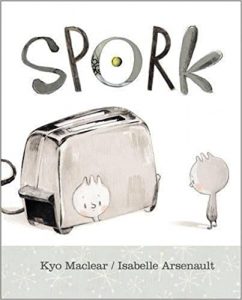Mental Health

Author(s): Kyo Maclear & Isabelle Arsenault
Links:
Amazon: https://amzn.to/2TxMRTm
Indigo: https://bit.ly/2TDteEz
Social Justice focus: Having a unique identity
Synopsis: This delightful tale features a spork (spoon and fork combo) who has trouble fitting in. He’s neither a spoon nor a fork and is never chosen as cutlery. Finally, his mixed abilities find their perfect use. The story could be applied generally to those who do not fit society’s molds, or more specifically to children of mixed racial backgrounds.
Lesson Plan: Alisdair Dunbar
Primary/Junior/Intermediate Lesson Plan (Abbreviated Template)
Consecutive and Concurrent Programs
Unit/Topic: Canadian Communities
Grade: 6
Lesson: An introduction to the idea of different communities within Canada and how communities are always changing.
Curriculum Areas: Literacy (Reading), Social Studies (Heritage and Identity)
Curriculum Expectations:
Literacy:
- Reading:
- 1.5 (Making Inferences/Interpreting Texts): develop interpretations about texts using stated and implied ideas to support their interpretations.
- 1.6 (Extending Understanding): extend understanding of texts by connecting, comparing, and contrasting the ideas in them to their own knowledge, experience, and insights, to other familiar texts, and to the world around them.
Social Studies:
- Heritage and Identity:
- A1.1, explain how various features, including built, physical, and social features of communities, can contribute to identities in and images of a territory and/or country.
Learning Goal(s): We are learning how to interpret the meaning of something we read, and understand how what we read/see sometimes is meant to represent something similar but different.
Success Criteria: Students have articulated (orally, in written form, or visually) that they understand some of the messages/themes of the book Spork at they can relate them to the subject of community identities in the real world.
MODIFICATIONS / ACCOMMODATIONS: Students can use assistive technology if they need for taking notes or writing answers.
Book will be read to students, and students can be given time with the book to take a closer look at illustrations, or to read it to themselves again.
Minds-on: How will I connect to prior and future learning? How will I engage students and set the context for learning?
Minutes: 10 minutes
Task: Students and teacher will discuss how books often have themes or messages. Teacher will discuss if students understand what a “theme” is and ask if they can give an example of a book they have read and the theme of that book. Teacher will then provide some examples of popular books, movies, etc. and ask students if they can identify some of the themes or messages.
Assessment: For, teacher will be assessing students’ prior knowledge of themes/messages and assessing their level of comfort with the topic. If necessary, teacher might need to provide more time to discuss themes with students.
Action: How will I introduce new learning / reinforce prior learning / practice learning / scaffold learning?
Minutes: 10-20 minutes
Task: Teacher will read the book Spork aloud to students. Teacher will then ask students to explain what the story was about, and some of the themes that were in the book and what messages the author may have trying to send to students about issues such as communities and identity.
Assessment: As, teacher will be assessing students’ reactions and discussion to gauge to what extent students are understanding some of the themes that are present (but not explicitly stated) in Spork.
Consolidation: How will I reflect on the learning goal? How will I have students reflect on the learning goal?
Minutes: 30-40 minutes
Task: Students will be asked to write down two main themes they took from the book Spork. They will then be asked to pick a group with which they are a part of (could be their family, ethnicity, race, school, a sports team, etc.) and identify the ways in which they are like that group, and the ways that they are different (like the Spork). Students can also show these similarities and differences by creating an illustration. As a final question, students will give an example of a place/group/time they have felt like a Fork/Spoon, and a place/group/time where they have felt like a spork.
Assessment: Of, teacher will be assessing the themes that students thought the book was about. (Did they see wider themes like identity or acceptance? Or did students see literal themes like cutlery, how to eat food, etc.) Teacher will also be seeing how students view the community they chose to focus on and what elements they think make them similar or different to that group.
MATERIALS: The book Spork. Students will need paper and pencil for answers. Colouring pencils/crayons can be used if students wish to make an illustration.
REFLECTION: Questions to determine the success of your lesson:
- Were my students successful in meeting the learning goals and success criteria? How do I know?
- Did my instructional decisions meet the needs of all students? If not, what are my next steps?
- What worked well and why?
- What will I do differently in the future when teaching this lesson? For the subsequent lesson?
- What are the next steps for my professional learning?

